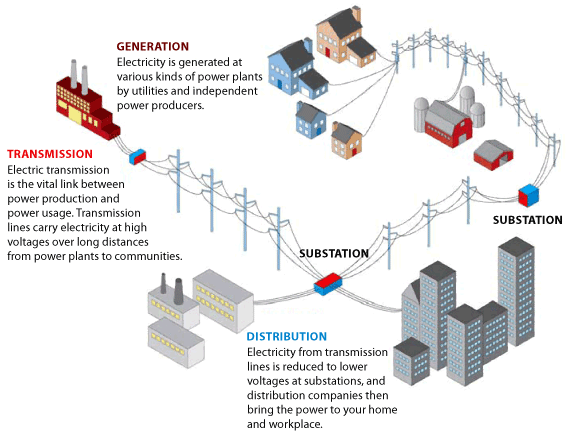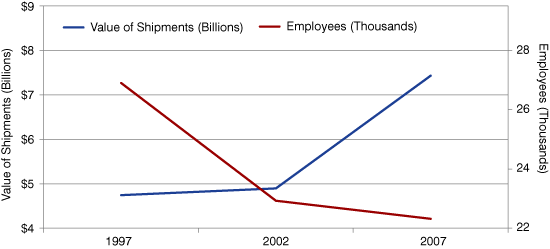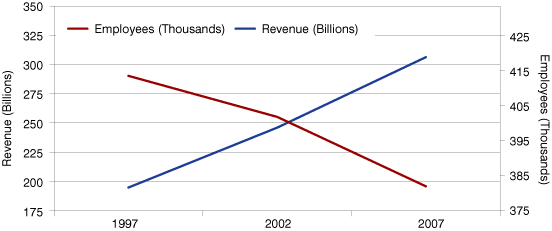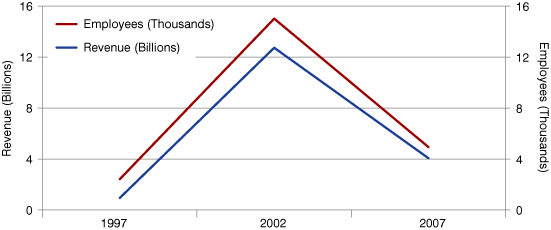The Electric Power Transmission and Distribution Industry
When people talk about the electric power industry, the focus of the conversation is usually on the power generation side of the business or on the utilities. The power generation side examines the extraction of fossil fuels, alternative energy generation, oil spills, carbon emissions, and nuclear power. The utilities side focuses on the customer-oriented delivery side of the business, from electricity bill surcharges to outages in our electricity supply.
A third and often overlooked portion of the power and energy industry is the transmission and distribution space (T&D), an important cluster of industries that include the production of machinery, electric lines and transformers as well as line management systems (such as "smart-grid" technology) that improve efficiency. These are responsible for the actual “delivery” of the electric power—no matter the generation source, be it solar, gas, oil, wind or otherwise—to commercial, private and industrial users in a usable format. Table 1 shows the T&D space relative to other power and energy sub-sectors by 2008 capital expenditure.
Table 1: Share of Infrastructure Spending for U.S. Electric Utilities by Power and Energy Sub-Sector, 2008
| Power and Energy Sub-Sector | Share of Infrastructure Spending |
|---|---|
| Generation | 35.9% |
| Distribution | 24.5% |
| Environment | 14.4% |
| Transmission | 11.7% |
| Other (Including Gas) | 13.5% |
Source: Edison Electric Institute
This article describes the T&D space within the energy economy and then summarizes the challenges yet tremendous growth potential for this cluster of industries given the aging U.S. infrastructure and rapid technological advancement of the developing world.
Understanding Key Elements of the T&D Space
The T&D market supplies equipment, services and production systems for energy markets. The initial stage in the process is converting power from a generation source (coal, nuclear, wind, etc.) into a high voltage electrical format that can be transported using the power grid, either overhead or underground. This “transformation” occurs very close to the source of the power generation. The second stage occurs when this high-voltage power is “stepped-down” by the use of switching gears and then controlled by using circuit breakers and arresters to protect against surges. This medium voltage electrical power can then be safely distributed to urban or populated areas. The final stage involves stepping the power down to useable voltage for the commercial or residential customer (see Figure 1).
Figure 1: Transmission and Distribution Grid Structure within the Power Industry

Source: U.S. Department of Energy. "Benefits of Using Mobile Transformers and Mobile Substations for Rapidly Restoring Electric Service: A Report to the United States Congress Pursuant to Section 1816 of the Energy Policy Act of 2005." 2006.
In short, while power generation relates to the installed capacity to produce energy from an organic or natural resource, the T&D space involves the follow up “post-power generation production” as systems and grids are put in place to transport this power to end users. While the T&D space does not perfectly follow typical industrial classification systems, its primary industries can be loosely distinguished from power generation as illustrated in Table 2.
Table 2: Industries Associated with Generation and Utilities Compared to the Transmission and Distribution Space, 2007
| Category | NAICS Code | Description of Industry |
|---|---|---|
| Generation and Utilities | 221111 | Hydroelectric Power Generation |
| 221112 | Fossil Fuel Electric Power Generation | |
| 221113 | Nuclear Electric Power Generation | |
| 221119 | Other Electric Power Generation | |
| 221122 | Electric Power Distribution* | |
| Transmission and Distribution (T&D) | 221121 | Electric Bulk Power Transmission and Control |
| 221122 | Electric Power Distribution* | |
| 335311 | Power, Distribution, and Specialty Transformer Manufacturing |
*The electric power distribution classification includes a substantial portion of electric power brokers and sales agents so it is categorized here as belonging to both generation and utilities as well as transmission and distribution.
Source: Indiana Business Research Center
Despite its name, only part of the electric power distribution industry belongs to the T&D space and most of it to the generation and utilities group since it includes a substantial number of traditional utility businesses that focus exclusively on the “sale of electricity via power distribution systems operated by others.”1
The T&D space is estimated to have a market share of over $50 billion globally and can be divided into four main segments, according to the organizational structure used by AREVA:2
- Products: Manufacture of high and medium voltage power and distribution transformers. The drivers for this market are the aging T&D infrastructure, load growth from sprawl, deregulation and general industrial growth.
- Services: Support for the products and systems sold throughout its lifecycle, usually contracts for repair and maintenance. The drivers for this segment are aging infrastructure, preventative maintenance and general outsourcing.
- Systems: Research and development of turnkey substations, electronics for direct current substations and systems to increase grid capacity and quality. This fast growing market is primarily driven by an increased need for power electronics, network efficiency, reliability, and new sources for renewable energy.
- Automation: Products to detect failures, ruptures and general protection arenas. This may also include systems for substation and energy management or for remote management for the power grid.
Revenue and Employment Trends in T&D-Related Sectors
Taking a closer look at three key industry sectors linked to the T&D space, we see that the increasing value of shipments and revenues is not necessarily linked to higher levels of employment.
Figure 2 reveals the value of shipments for the power, distribution and specialty transformer manufacturing industry, which made a dramatic 50 percent increase (from $4.9 billion to $7.4 billion) between 2002 to 2007 despite scant growth during the previous five-year period. However, employment continued to fall in the industry, albeit slower between 2002 to 2007 (-3 percent) than the 15 percent drop between 1997 and 2002.
Figure 2: U.S. Value of Shipments and Number of Employees for the Power, Distribution and Specialty Transformer Manufacturing Industry, 1997 to 2007

Source: IBRC, using U.S. Census Bureau Economic Census data for NAICS 335311
We observe a similar trend for the massive electric power distribution industry which contains portions of the T&D space (see Figure 3). While revenues increased more than $111 billion (57 percent) between 1997 and 2007, employment gradually decreased from 413 million employees in 1997 and 401 million in 2002 to 381 million in 2007—an 8 percent drop overall.
Figure 3: U.S. Revenues and Number of Employees for the Electric Power Distribution Industry, 1997 to 2007

Source: IBRC, using U.S. Census Bureau Economic Census data for NAICS 221122
Only in the highly volatile electric power transmission and control industry do we see a more positive correlation between revenue and employment (see Figure 4). The twelve-fold jump in revenues from $1 billion to $13 billion between 1997 and 2002 occurred at the same time the workforce grew to 15,000 employees—five times its size at the start of the five-year period. Then, as revenues plunged to $4 billion (down 68 percent) by 2007, employment dropped 67 percent to 5,000 employees.
Figure 4: U.S. Revenues and Number of Employees for the Electric Power Transmission & Control Industry, 1997 to 2007

Source: IBRC, using U.S. Census Bureau Economic Census data for NAICS 221121
Growth Potential of the T&D Space
While GE is the largest U.S. firm that participates in the T&D space, it lags far behind European companies ABB and Siemens and recently failed in its bid to acquire AREVA—the third largest global competitor.3 Most of the growth in this sector is taking place in developing countries, particularly through the manufacture of large transformers outside the United States, thus increasing competition with parts and equipment suppliers across the globe.4 Emerging markets are also increasingly the major demand side partners for T&D firms with over two-thirds of current power generation products being built outside of North America and Europe, with China alone representing almost 24 percent.5
According to the Edison Electric Institute, projected T&D spending of utilities for 2011 is going to top $11 billion in the United States.6 This level of spending is mandated by the U.S. government to service existing systems, to incorporate smart grid technologies into the current infrastructure, to enable both off-shore and land-based wind power generation towers to be part of the current system and to promote spending and growth of solar technologies and improved efficiency in the current system.
The U.S. T&D space has strong growth potential with the increasing need to replace aging transformers. Through a widely cited study, William Bartley found the average failure age for U.S. transformers was 18 years and the failure rate increases exponentially at the 30-year mark. This is alarming since the majority of current U.S. transformers were installed in the 1970s or earlier.7 Bartley found that transformer failures were already on the rise with a total of 94 power losses from 1997 to 2001 resulting in total costs of over $286 million. These facts present both a challenge and an opportunity for the T&D industry since analysts predict we are fast approaching an “asset wall” since the U.S. would require more than a 30 percent jump in T&D investment to replace aging infrastructure between 2007 and 2017.8
As the United States continues to discuss efficiency and a comprehensive plan for smarter energy, we can expect to see tremendous growth in the T&D space. However, higher values of shipments and revenues do not necessarily lead to higher employment, so special efforts may be needed to ensure that direct or indirect U.S. job creation occurs as T&D investment increases. In particular, more stable investment may be needed for the promising, yet volatile, electric power transmission and control industry where revenues seem most directly linked to job creation.
Notes
- More information on the North American Industrial Classification System (NAICS) can be found at: www.census.gov/cgi-bin/sssd/naics/naicsrch?chart=2007.
- AREVA was one of the world’s leading T&D companies before the recent sale of its T&D division. This information comes from the AREVA 2009 Reference Document filed with the French financial market authority. It is available at www.areva.com/finance/liblocal/docs/2009/Doc%20de%20ref%202009_vdef2_vUK_08042010.pdf.
- Gianluca Baratti, “Areva Unit Goes to French Buyers, ”Business Week, December 2009.
- U.S. Department of Energy, “Benefits of Using Mobile Transformers and Mobile Substations for Rapidly Restoring Electric Service: A Report To The United States Congress Pursuant To Section 1816 of the Energy Policy Act Of 2005,” 2005.
- The AREVA 2009 Reference Document is available at www.areva.com/finance/liblocal/docs/2009/Doc%20de%20ref%202009_vdef2_vUK_08042010.pdf.
- Marc W. Chupka, Robert Earle, Peter Fox-Penner, and Ryan Hledik, "Transforming America's Power Industry: The Investment Challenge 2010-2030," The Brattle Group / The Edison Foundation, 2008, https://www.edisonfoundation.net/-/media/Files/IEI/publications/Transforming_Americas_Power_Industry.pdf.
- William H. Bartley, "Analysis of Transformer Failures" (paper presented at the 36th Annual Conference of International Association of Engineering Insurers, Stockholm, 2003), www.dslreports.com/r0/download/2090605~b4c1ba766bdaf00a1ced03b745ff4fe7/transformer_failures.pdf
- For more information, please see Thomas A. Prevost and David J. Woodcock’s “Transformer Fleet Health and Risk Assessment,” IEEE Power & Energy Society Transformers Committee Tutorial, March 13, 2007.
Ali Arif Merchant
Research Assistant, Indiana Business Research Center, Indiana University Kelley School of Business
Michael F. Thompson, Economic Research Analyst, Indiana Business Research Center, Indiana University Kelley School of Business
